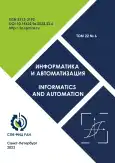Vol 22, No 6 (2023)
Artificial intelligence, knowledge and data engineering
Real-Time Reliability Monitoring on Edge Computing: a Systematic Mapping
Abstract
Scenario: System reliability monitoring focuses on determining the level at which the system works as expected (under certain conditions and over time) based on requirements. The edge computing environment is heterogeneous and distributed. It may lack central control due to the scope, number, and volume of stakeholders. Objective: To identify and characterize the Real-time System Reliability Monitoring strategies that have considered Artificial Intelligence models for supporting decision-making processes. Methodology: An analysis based on the Systematic Mapping Study was performed on December 14, 2022. The IEEE and Scopus databases were considered in the exploration. Results: 50 articles addressing the subject between 2013 and 2022 with growing interest. The core use of this technology is related to networking and health areas, articulating Body sensor networks or data policies management (collecting, routing, transmission, and workload management) with edge computing. Conclusions: Real-time Reliability Monitoring in edge computing is ongoing and still nascent. It lacks standards but has taken importance and interest in the last two years. Most articles focused on Push-based data collection methods for supporting centralized decision-making strategies. Additionally, to networking and health, it concentrated and deployed on industrial and environmental monitoring. However, there are multiple opportunities and paths to walk to improve it. E.g., data interoperability, federated and collaborative decision-making models, formalization of the experimental design for measurement process, data sovereignty, organizational memory to capitalize previous knowledge (and experiences), calibration and recalibration strategies for data sources.
 1243-1295
1243-1295


A Balanced Intrusion Detection System for Wireless Sensor Networks in a Big Data Environment Using CNN-SVM Model
Abstract
Wireless Sensor Networks (WSNs) were exposed to several distinct safety issues and attacks regarding gathering and sending data. In this scenario, one of the most prevalent WSN assaults that may target any tier of the protocol stack is the Denial of Service (DoS) attack. The current research suggested various strategies to find the attack in the network. However, it has classification challenges. An effective ensemble deep learning-based intrusion detection system to identify the assault in the WSN network was, therefore, suggested in this research to address this issue. The data pre-processing involves converting qualitative data into numeric data using the One-Hot Encoding technique. Following that, Normalization Process was carried out. Then Manta-Ray Foraging Optimization is suggested to choose the best subset of features. Then Synthetic Minority Oversampling Technique (SMOTE) oversampling creates a new minority sample to balance the processed dataset. Finally, CNN–SVM classifier is proposed to classify the attack kinds. The Accuracy, F-Measure, Precision, and Recall metrics were used to assess the outcomes of 99.75%, 99.21%, 100%, and 99.6%, respectively. Compared to existing approaches, the proposed method has shown to be extremely effective in detecting DoS attacks in WSNs.
 1296-1322
1296-1322


Algorithm of Constituency Tree from Dependency Tree Construction for a Russian-Language Sentence
Abstract
 1323-1353
1323-1353


Robotics, automation and control systems
Motion Primitives in the Trajectory Planning Problem with Kinematic Constraints
Abstract
 1354-1386
1354-1386


Application of Harmonic Half-Waves for Automation of High-Speed Trains Control
Abstract
 1387-1414
1387-1414


Mathematical modeling and applied mathematics
Mathematical Modeling of the Processes of Executing Packages of Tasks in Conveyor Systems with Intermediate Buffers of Limited Size
Abstract
 1415-1450
1415-1450


On the Partial Stability of Nonlinear Discrete-Time Systems with Delay
Abstract
 1451-1472
1451-1472


Vegetation Indices (NDVI and EVI) Time Series Approximation for Monitoring Crops of Khabarovsk Territory
Abstract
 1473-1498
1473-1498


Forecasting in Stock Markets Using the Formalism of Statistical Mechanics
Abstract
 1499-1541
1499-1541











